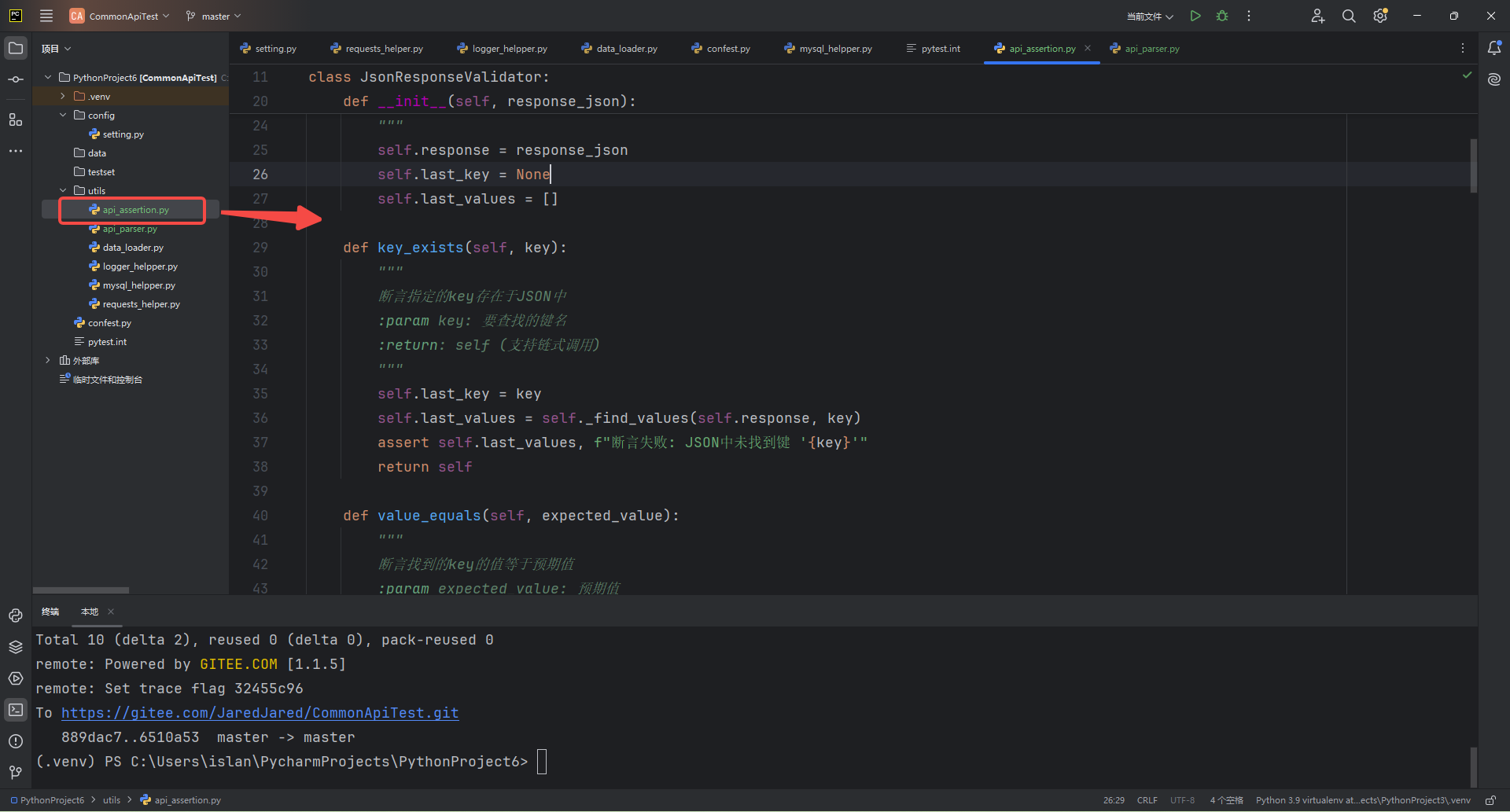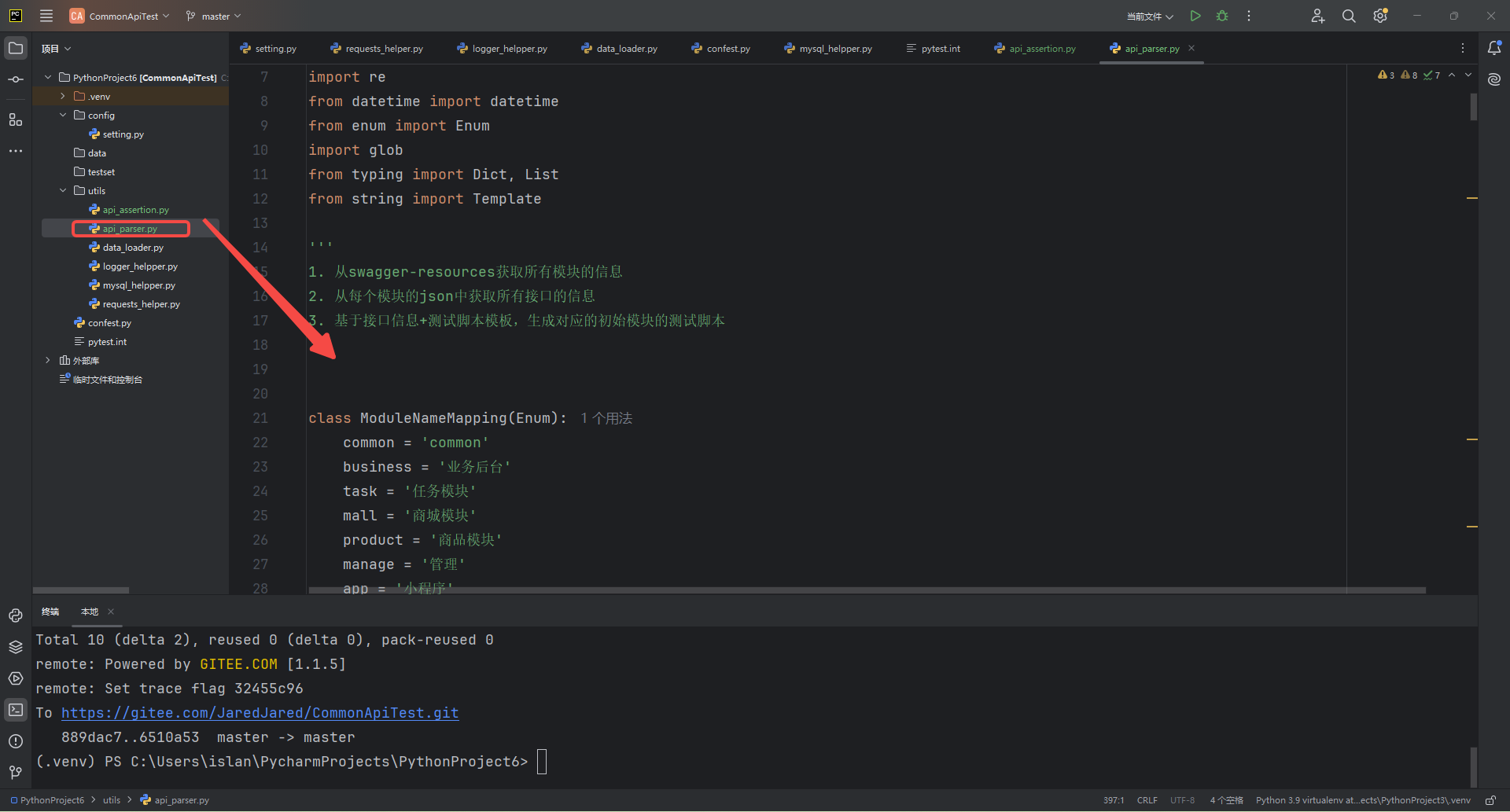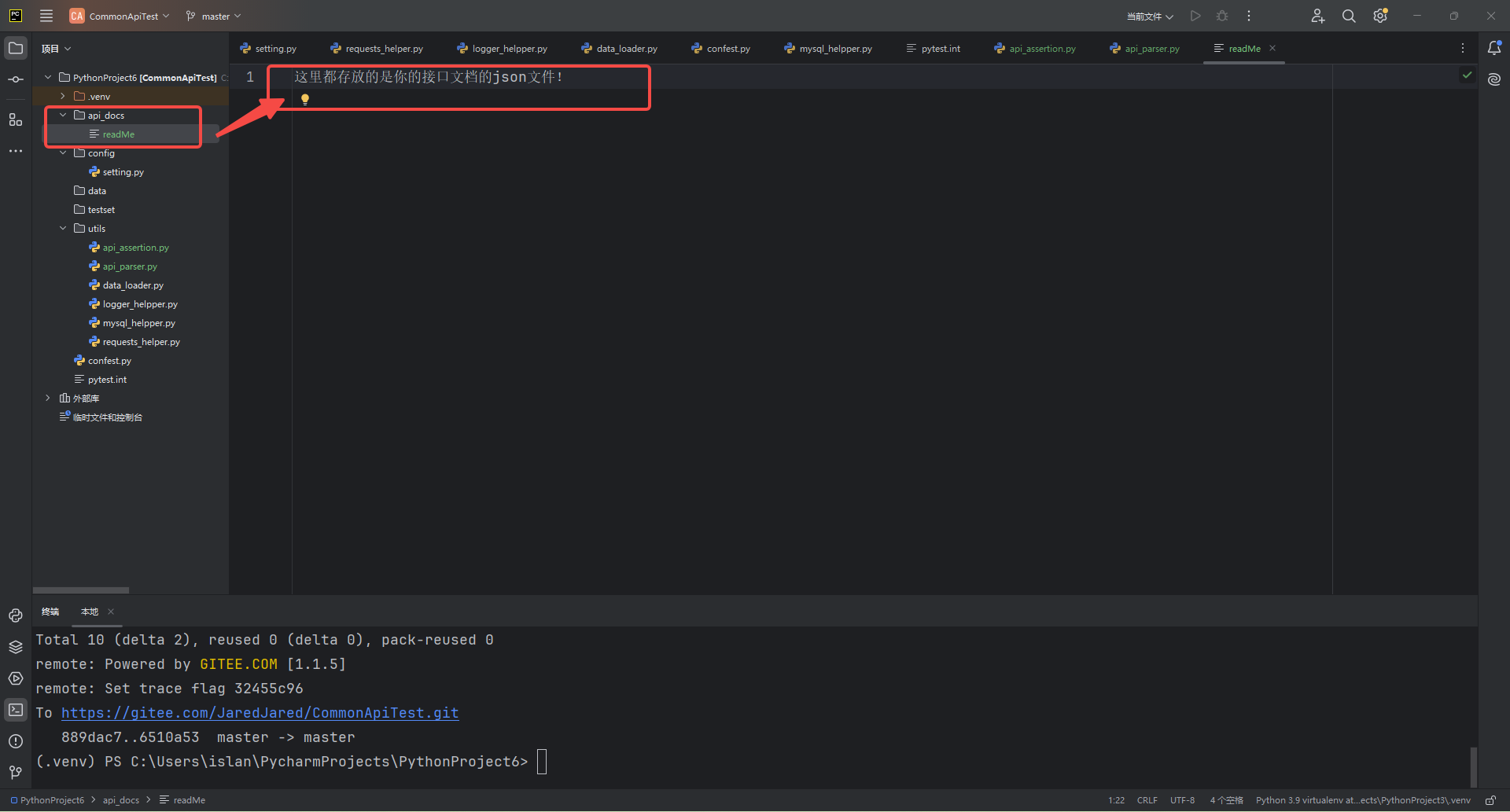自动化接口框架搭建分享-pytest第三部分
本文介绍了一个自动化接口测试框架的实现方案。该框架通过解析Swagger/OpenAPI文档自动生成测试脚本,主要包含以下组件:1. 核心工具类:包括HTTP请求封装、数据加载器、JSON响应验证器(支持键值存在性检查、值匹配、范围比较等12种断言方法)和日志记录工具;2. 自动化脚本生成器:通过解析API文档自动生成测试用例或API调用模块;3. 测试执行体系:基于Pytest框架,包含配置文件
在解决完我们的
- 环境与依赖 (requirements.txt)
- 配置管理 (config/setting.py)
- HTTP 请求封装 (utils/requests_helper.py)
- 数据加载器 (utils/data_loader.py 和 data/)
- 测试框架基础 (pytest.ini, conftest.py
我们现在来完成最后一步的工作!
API 响应解析与断言 (utils/api_parser.py, utils/api_assertion.py)与CI/CD的集成
API断言中

api_asserti.py(断言类)->专门用于对 API 返回的 JSON 响应进行各种断言验证
# /usr/bin/python3
# coding=utf-8
import sys
sys.path.append("..")
sys.path.append(".")
sys.dont_write_bytecode = True
class JsonResponseValidator:
"""
JSON响应断言类
功能:
1. 检查JSON中是否存在指定key
2. 检查指定key的值是否符合预期
3. 支持嵌套JSON结构和数组遍历
"""
def __init__(self, response_json):
"""
初始化断言类
:param response_json: 要验证的JSON数据(dict/list)
"""
self.response = response_json
self.last_key = None
self.last_values = []
def key_exists(self, key):
"""
断言指定的key存在于JSON中
:param key: 要查找的键名
:return: self (支持链式调用)
"""
self.last_key = key
self.last_values = self._find_values(self.response, key)
assert self.last_values, f"断言失败: JSON中未找到键 '{key}'"
return self
def value_equals(self, expected_value):
"""
断言找到的key的值等于预期值
:param expected_value: 预期值
:return: self (支持链式调用)
"""
assert self.last_key is not None, "必须先调用key_exists()方法"
assert expected_value in self.last_values, (
f"断言失败: 键 '{self.last_key}' 的值不等于预期值\n"
f"预期: {expected_value}\n"
f"实际找到的值: {self.last_values}"
)
return self
def value_contains(self, expected_part):
"""
断言找到的key的值包含预期字符串(部分匹配)
:param expected_part: 预期包含的字符串
:return: self (支持链式调用)
"""
assert self.last_key is not None, "必须先调用key_exists()方法"
found = any(str(expected_part) in str(val) for val in self.last_values)
assert found, (
f"断言失败: 键 '{self.last_key}' 的值不包含预期内容\n"
f"预期包含: {expected_part}\n"
f"实际找到的值: {self.last_values}"
)
return self
def value_not_contains(self, unexpected_part):
"""
断言所有找到的值不包含指定内容
"""
assert self.last_key is not None, "必须先调用key_exists()方法"
invalid = [v for v in self.last_values if str(unexpected_part) in str(v)]
assert not invalid, f"值不应包含{unexpected_part},但发现{len(invalid)}个违规值"
return self
def value_not_null(self):
"""
断言找到的key的值不为空
:return: self (支持链式调用)
"""
assert self.last_key is not None, "必须先调用key_exists()方法"
null_values = [val for val in self.last_values if val in (None, "", [], {})]
assert not null_values, (
f"断言失败: 键 '{self.last_key}' 存在空值\n"
f"找到的空值数量: {len(null_values)}/{len(self.last_values)}\n"
f"所有空值: {null_values}"
)
return self
def value_is_null(self):
"""
断言找到的key的值为空
:return: self (支持链式调用)
"""
assert self.last_key is not None, "必须先调用key_exists()方法"
invalid_values = [val for val in self.last_values if val not in (None, "", [], {})]
assert not invalid_values, (
f"断言失败: 键 '{self.last_key}' 存在非空值\n"
f"找到的非空值数量: {len(invalid_values)}/{len(self.last_values)}\n"
f"所有非空值: {invalid_values}"
)
return self
def value_is_true(self):
"""
断言所有找到的值为True(严格校验布尔类型)
"""
assert self.last_key is not None, "必须先调用key_exists()方法"
invalid = [v for v in self.last_values if not isinstance(v, bool) or v != True]
assert not invalid, f"值应全为True,但发现{len(invalid)}个非True值"
return self
def value_is_false(self):
"""
断言所有找到的值为False(严格校验布尔类型)
"""
assert self.last_key is not None, "必须先调用key_exists()方法"
invalid = [v for v in self.last_values if not isinstance(v, bool) or v != False]
assert not invalid, f"值应全为False,但发现{len(invalid)}个非False值"
return self
def value_greater_than(self, ref_value):
"""
断言找到的key的值大于
:return: self (支持链式调用)
"""
assert self.last_key is not None, "必须先调用key_exists()方法"
# 找出所有不大于参考值的无效值
invalid_values = [val for val in self.last_values if val <= ref_value]
# 如果存在无效值则断言失败
assert not invalid_values, (
f"断言失败: 键 '{self.last_key}' 存在不大于 {ref_value} 的值\n"
f"不符合数量: {len(invalid_values)}/{len(self.last_values)}\n"
f"无效值列表: {invalid_values}"
)
return self
def value_less_than(self, ref_value):
"""
断言找到的key的值小于指定参考值
:param ref_value: 要比较的参考值(所有找到的值必须小于该值)
:return: self (支持链式调用)
"""
assert self.last_key is not None, "必须先调用key_exists()方法"
# 找出所有不小于参考值的无效值
invalid_values = [val for val in self.last_values if val >= ref_value]
# 如果存在无效值则断言失败
assert not invalid_values, (
f"断言失败: 键 '{self.last_key}' 存在不小于 {ref_value} 的值\n"
f"不符合数量: {len(invalid_values)}/{len(self.last_values)}\n"
f"无效值列表: {invalid_values}"
)
return self
def _find_values(self, data, search_key):
"""
递归查找JSON中所有匹配的键值
:param data: 要搜索的数据(dict/list)
:param search_key: 要查找的键
:return: 找到的值列表
"""
results = []
if isinstance(data, dict):
for key, value in data.items():
if key == search_key:
results.append(value)
# 递归搜索嵌套结构
if isinstance(value, (dict, list)):
results.extend(self._find_values(value, search_key))
elif isinstance(data, list):
for item in data:
if isinstance(item, (dict, list)):
results.extend(self._find_values(item, search_key))
return results
def get_first_value(self):
"""
获取找到的第一个值
:return: 第一个匹配的值
"""
assert self.last_values, "没有找到任何值"
self.last_values = [self.last_values[0]]
return self
def get_all_values(self):
"""
获取找到的所有值
:return: 所有匹配的值列表
"""
return self.last_values简单的说,它封装了这数十种方法:
api_parser.py(测试脚本)

# /usr/bin/env python3
# coding=utf-8
import requests
import json
import os
import re
from datetime import datetime
from enum import Enum
import glob
from typing import Dict, List
from string import Template
'''
1. 从swagger-resources获取所有模块的信息
2. 从每个模块的json中获取所有接口的信息
3. 基于接口信息+测试脚本模板,生成对应的初始模块的测试脚本
'''
class ModuleNameMapping(Enum):
common = 'common'
business = '业务后台'
task = '任务模块'
mall = '商城模块'
product = '商品模块'
manage = '管理'
app = '小程序'
def get_swagger_resource_path(domain: str) -> dict:
"""请求指定URL并返回JSON响应结果"""
headers = {
"User-Agent": "Mozilla/5.0 (Windows NT 10.0; Win64; x64) AppleWebKit/537.36 (KHTML, like Gecko) Chrome/125.0.0.0 Safari/537.36"
}
url = domain + "/swagger-resources"
try:
response = requests.get(url, headers=headers, timeout=10)
response.raise_for_status() # 自动处理HTTP错误状态码
return {
"status_code": response.status_code,
"success": True,
"data": response.json()
}
except requests.exceptions.RequestException as e:
return {
"status_code": getattr(e.response, 'status_code', 500),
"success": False,
"error": f"请求失败: {str(e)}"
}
except json.JSONDecodeError:
return {
"status_code": 500,
"success": False,
"error": "响应内容不是有效的JSON格式"
}
def get_swagger_module_json(domain: str, module_info: dict):
"""请求指定URL并返回JSON响应结果"""
headers = {
"User-Agent": "Mozilla/5.0 (Windows NT 10.0; Win64; x64) AppleWebKit/537.36 (KHTML, like Gecko) Chrome/125.0.0.0 Safari/537.36"
}
api = module_info.get("url")
api_name = module_info.get("name")
url = domain + api
try:
response = requests.get(url, headers=headers, timeout=10)
response.raise_for_status() # 自动处理HTTP错误状态码
return {
"status_code": response.status_code,
"success": True,
"data": response.json()
}
except requests.exceptions.RequestException as e:
return {
"status_code": getattr(e.response, 'status_code', 500),
"success": False,
"error": f"请求失败: {str(e)}"
}
except json.JSONDecodeError:
return {
"status_code": 500,
"success": False,
"error": "响应内容不是有效的JSON格式"
}
def extract_component_by_name(json_file: str, origin_schema_name: str) -> Dict:
"""从OpenAPI格式的JSON文件中提取指定名称的组件"""
with open(json_file, 'r', encoding='utf-8') as f:
spec = json.load(f)
# 从origin_schema_name中提取实际需要的schema名称
exp_schema_name = origin_schema_name.split('/')[-1]
# 遍历所有组件,查找指定名称的组件
components = spec.get('components', {})
schemas = components.get('schemas', {})
if exp_schema_name in schemas.keys():
schema_properties = schemas[exp_schema_name].get('properties', {})
# print(schema_properties)
return schema_properties
def extract_endpoints(json_file: str) -> List[Dict]:
"""从OpenAPI格式的JSON文件中提取接口信息"""
with open(json_file, 'r', encoding='utf-8') as f:
spec = json.load(f)
endpoints = []
# 遍历所有接口路径
for path, methods in spec.get('paths', {}).items():
# 遍历每个HTTP方法
for method, details in methods.items():
endpoint = {
'name': details.get('summary', 'Unknown API'),
'path': path,
'method': method.upper(),
'requestBody': [],
'parameters': [],
'responses': []
}
# 提取请求参数
for param in details.get('parameters', []):
endpoint['parameters'].append({
'name': param.get('name'),
'in': param.get('in'), # path/query/header/cookie
'required': param.get('required', False),
'description': param.get('description')
})
# 提取Body参数
if 'requestBody' in details.keys():
request_body = details['requestBody']
if 'content' in request_body.keys():
content = request_body['content']
for content_type, schema in content.items():
if 'schema' in schema.keys():
# 读取schema的ref信息,如果不存在则可能报错
target_schema_name = schema['schema'].get('$ref', '')
endpoint['requestBody'] = extract_component_by_name(json_file, target_schema_name)
# 提取响应信息
for status_code, response in details.get('responses', {}).items():
endpoint['responses'].append({
'status': status_code,
'description': response.get('description'),
'content_type': list(response.get('content', {}).keys())
})
endpoints.append(endpoint)
return endpoints
def generate_pytest_script(module_name: str, endpoints: List[Dict]) -> str:
"""生成pytest测试脚本"""
test_template = Template('''"""
基于Swagger Doc, 通过解析内容生成的接口测试脚本 - $module_name
生成时间:${timestamp}
"""
#/usr/bin/python3
# coding=utf-8
import json
import pytest
from utils.api_assertion import JsonResponseValidator
from utils.data_loader import load_yaml_testdata
class Test${module_name}:
"""${module_name}接口测试类"""
$test_cases
''')
case_template = Template('''
@pytest.mark.$case_tag # 新增标签标记
def test_${case_name}(self, api_client, case_data=None, **kwargs):
"""$api_name"""
api_url='$url'
method = '$method'
params = None
data = None
if case_data:
params = case_data.get("params", None)
data = case_data.get("data", None)
if method.lower() == 'post':
data = json.dumps(data)
# 发送接口请求
response = api_client.send_request(
method=method,
endpoint=api_url,
params=params,
data=data
)
# 断言
validator = JsonResponseValidator(response.json())
if case_data:
for assertion in case_data["assertions"]:
if "value_equals" in assertion:
validator.key_exists(assertion["key"]).value_equals(assertion["value_equals"])
elif "value_contains" in assertion:
validator.key_exists(assertion["key"]).value_contains(assertion["value_contains"])
else:
validator.key_exists("code").value_equals(200)
# ... 其他断言
''')
cases = []
for endpoint in endpoints:
# 处理URL路径参数
api_path = endpoint['path']
# 构造模板数据
case_data = {
'case_tag': module_name, # 新增标签字段
'case_name': api_path.lstrip('/').replace('/', '_').replace('-', '_'),
'api_name': endpoint.get('name'),
'method': endpoint.get('method'),
'url': api_path,
'request_body': endpoint.get('requestBody'),
'params': endpoint.get('parameters'),
'data': endpoint.get('requestBody', {}), # 添加data字段的默认值
}
cases.append(case_template.substitute(case_data))
return test_template.substitute(
module_name=module_name,
timestamp=datetime.now().strftime("%Y-%m-%d %H:%M:%S"),
test_cases='\n'.join(cases)
)
def generate_module_script(module_name: str, endpoints: List[Dict]) -> str:
"""将swagger api转换成python module, 并实现业务串联"""
test_template = Template('''
"""
自动生成的接口文件 - $module_name
生成时间:${timestamp}
"""
import sys
sys.path.append(".")
sys.path.append("..")
sys.donot_write_bytecode = True
from utils.api_client import APIRequest
from typing import Any, Dict
$test_cases
''')
case_template = Template('''
def ${func_name}(api_client: APIRequest, method='${method}',params=None, payload=None, **kwargs):
"""${api_summary}"""
url = "${raw_path}"
# 发送请求
response = api_client.send_request(
method=method,
api_url=url,
params = params,
data = payload
)
return response
''')
cases = []
for endpoint in endpoints:
# 解析路径参数(如 /users/{id})
path_params = re.findall(r'\{(\w+)\}', endpoint['path'])
raw_path = endpoint['path']
# 生成方法参数和请求参数映射
param_sections = []
request_mappings = []
path_format_args = []
# 1. 处理路径参数
if path_params:
for p in path_params:
param_sections.append(f"{p}: str")
path_format_args.append(f"{p}={p}")
param_sections.append("") # 参数换行分隔
# 2. 处理查询参数 (修正此处逻辑)
query_params = [p for p in endpoint['parameters'] if p['in'] == 'query']
query_params_section = "**params: Dict[str, Any]" if query_params else ""
if query_params:
param_sections.append(query_params_section)
request_mappings.append("'params': params")
# 3. 处理请求体
body_param_section = "payload: Dict[str, Any]" if endpoint['requestBody'] else ""
if endpoint['requestBody']:
param_sections.append(body_param_section)
request_mappings.append("'json': payload")
# 构造模板数据(确保包含所有模板变量)
case_data = {
'func_name': raw_path.lstrip('/').replace('/', '_'),
'api_summary': endpoint.get('name', '未知接口'),
'method': endpoint['method'].lower(),
'raw_path': raw_path,
'path_params': ",\n ".join(param_sections),
'query_params': query_params_section, # 确保变量存在
'body_param': body_param_section, # 确保变量存在
'path_format_args': ", ".join(path_format_args),
'request_params_body': ",\n ".join(request_mappings),
'request_arguments': ",\n ".join(request_mappings)
}
cases.append(case_template.substitute(case_data))
return test_template.substitute(
module_name=module_name,
timestamp=datetime.now().strftime("%Y-%m-%d %H:%M:%S"),
test_cases='\n'.join(cases)
)
def generate_swagger_api_json_file_entry(domain: str, project_root_path: str):
result = get_swagger_resource_path(domain)
if result['success']:
module_list = result['data']
# 创建存储所有接口的列表
all_endpoints = []
for module_info in module_list:
# 添加模块信息打印
print(f"\n正在获取模块: {module_info['name']} ({module_info['url']})")
module_name = [item.name for item in ModuleNameMapping if item.value == module_info['name']][0]
module_result = get_swagger_module_json(domain, module_info)
if module_result['success']:
# 将获取的API文档保存为临时文件
temp_file = f"swagger_{module_name}.json"
api_doc_file = os.path.join(project_root_path, 'api_docs', temp_file)
print(api_doc_file)
with open(api_doc_file, 'w', encoding='utf-8') as f:
json.dump(module_result['data'], f, ensure_ascii=False)
else:
print(f"模块 {module_info['name']} 请求失败: {module_result['error']}")
else:
print("请求异常:", result['error'])
def generate_api_script_file_by_name(project_root_path: str, type_name: str):
# 在文件保存后添加生成测试脚本的逻辑
output_file = None
api_docs_dir = os.path.join(project_root_path, 'api_docs')
module_folder = 'testset' if type_name == 'tests' else 'modules'
module_dir = os.path.join(project_root_path, module_folder)
os.makedirs(module_dir, exist_ok=True)
# 遍历所有临时文件
for temp_file in glob.glob(os.path.join(api_docs_dir, 'swagger_*.json')):
module_name = os.path.basename(temp_file).split('_', 1)[1].split('.')[0]
# 提取接口信息
endpoints = extract_endpoints(temp_file)
# 生成测试脚本
if module_folder == 'testset':
script_content = generate_pytest_script(module_name, endpoints)
output_file = os.path.join(module_dir, f'test_{module_name}_api.py')
else:
script_content = generate_module_script(module_name, endpoints)
output_file = os.path.join(module_dir, f'{module_name}_api.py')
# 保存测试文件
with open(output_file, 'w', encoding='utf-8') as f:
f.write(script_content)
print(f"已生成测试脚本: {output_file}")
if __name__ == "__main__":
domain = 'https:whatisyourweb.com/api/'
project_root_path = 'whatisyourpath'
# generate_swagger_api_json_file_entry(domain, project_root_path)
generate_api_script_file_by_name(project_root_path, 'tests')
# json_file = os.path.join(project_root_path, 'api_docs', 'swagger_mall.json')
# extract_endpoints(json_file)
如上所述 1. 从swagger-resources获取所有模块的信息 2. 从每个模块的json中获取所有接口的信息 3. 基于接口信息+测试脚本模板,生成对应的初始模块的测试脚本
当然,简单来说
- `get_swagger_resource_path` :请求 Swagger API 的 /swagger-resources 接口,获取所有模块的资源路径信息。
- `get_swagger_module_json` :根据模块资源路径,请求并获取特定 Swagger 模块的详细 JSON 文档。
- `extract_component_by_name` :从 OpenAPI 格式的 JSON 文件中,根据组件名称提取其详细定义(通常用于解析请求体或响应体的结构)。
- `extract_endpoints` :从 OpenAPI 格式的 JSON 文件中解析出所有 API 接口的详细信息,包括路径、方法、参数、请求体和响应。
- `generate_pytest_script` :根据提取的 API 接口信息,生成符合 Pytest 框架的测试脚本内容。
- `generate_module_script` :根据提取的 API 接口信息,生成 Python 模块文件,封装 API 调用逻辑。
- `generate_swagger_api_json_file_entry` :作为入口函数,通过请求 Swagger API 获取所有模块的 JSON 文档,并将其保存到本地的 api_docs 文件夹中。
- `generate_api_script_file_by_name` :遍历本地保存的 Swagger JSON 文件,提取接口信息,并根据指定类型( tests 或 modules )生成相应的测试脚本或 API 模块文件。
它能够读取 Swagger API 文档,然后自动生成测试用例文件或者封装好的 API 调用模块,极大地提高了测试开发的效率。
我们也能在上面看到,我们的接口文件应该怎么写
class Test${module_name}:
"""${module_name}接口测试类"""
$test_cases
''')
case_template = Template('''
@pytest.mark.$case_tag # 新增标签标记
def test_${case_name}(self, api_client, case_data=None, **kwargs):
"""$api_name"""
api_url='$url'
method = '$method'
params = None
data = None
if case_data:
params = case_data.get("params", None)
data = case_data.get("data", None)
if method.lower() == 'post':
data = json.dumps(data)
# 发送接口请求
response = api_client.send_request(
method=method,
endpoint=api_url,
params=params,
data=data
)
# 断言
validator = JsonResponseValidator(response.json())
if case_data:
for assertion in case_data["assertions"]:
if "value_equals" in assertion:
validator.key_exists(assertion["key"]).value_equals(assertion["value_equals"])
elif "value_contains" in assertion:
validator.key_exists(assertion["key"]).value_contains(assertion["value_contains"])
else:
validator.key_exists("code").value_equals(200)
# ... 其他断言
''')
同样的,这个api_docs也因业务而异!。

基于此,基本的框架整体就搭建完毕了,它拥有一套完整的测试体系
这一整套逻辑是:
首先, 准备环境 ,安装 requirements.txt 中列出的所有依赖。
接着, 配置基础信息 ,在 `setting.py` 中定义 API 的基本 URL、环境等。
然后, 构建核心工具 ,包括封装 HTTP 请求的 `requests_helper.py` 、加载测试数据的 `data_loader.py` 、处理 JSON 响应断言的 `api_assertion.py` 和记录日志的 `logger_helper.py` 。
在此基础上,利用 `api_parser.py` 自动化生成测试骨架 ,它会解析 api_docs 文件夹中的 Swagger/OpenAPI 文档,生成 testset/ 或 modules/ 目录下的测试脚本。
最后, 配置 Pytest 运行机制 ,通过 `confest.py` 定义共享的测试夹具和钩子,并在 `pytest.ini` 中设置测试发现规则和运行参数,从而实现高效、自动化的接口测试。
CI/CD
Allure的HTML报告这两项我在后面番外篇再给你们出
更多推荐
 已为社区贡献1条内容
已为社区贡献1条内容









所有评论(0)